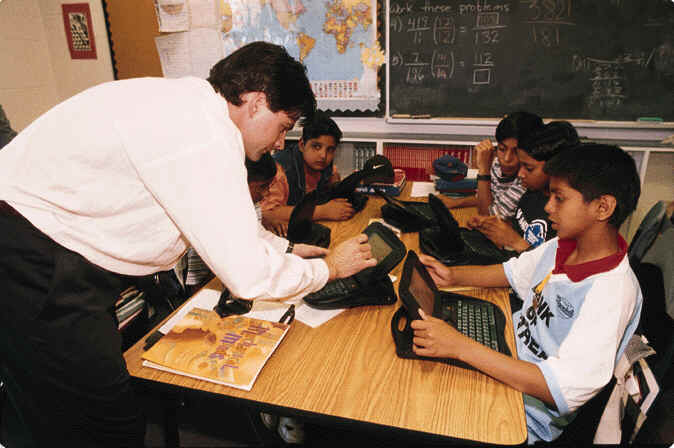Etobicoke
Students Get the Mobile Edge
Exciting
portable computers make primary students adept users
– and better learners.
By Dwight Klassen
The idea behind a distributed
learning environment is nothing new. For centuries,
teachers have been urging students to go out and
explore the world around them.
What is new is
the technology making it possible for modern students
to take the information they encounter around them
and integrate it directly and instantly with the core
classroom curriculum.
At John D.
Parker Junior Public School in Etobicoke, the worlds
of the classroom, the library, the laboratory, the
home and the community are now being seen as one
continuous field of exploration, discovery and
learning.
During May and
June, four classes began integrating Apple
Canada’s eMate 300 mobile computers into
normal school work. The Apple eMates, designed
specifically to help schools improve the
computer/student ratio in the classroom, complement
John D. Parker’s existing desktop computers.

Kevin Fisher and
students at John D. Parker in Etobicoke
work with eMates.
The eMate was
designed as a companion to Mac OS and Windows-based
PCs. It has an easy-to-use Newton operating system
and comes with Newton Works, a set of built-in
applications including a word processor, drawing
programs, spreadsheet and graphing calculator.
The units are
very rugged and completely portable – designed
so that students can cradle them on one arm while
they type or use a stylus with their other hand. A
very popular feature with young students allows them
to beam information from one computer to another via
a built-in infra-red device. They run for 28 hours on
a battery that takes one hour to recharge.
Anywhere,
any time
"The
distributed learning environment is all about making
technology a true anywhere-any time tool for
students," says Gordon McKye, Principal of
Information Technology at the Etobicoke board.
"By extending the reach of learning, students
are encouraged to create, communicate and collaborate
like never before. And because the cost is
substantially less than traditional computers, we are
able to put more technology in each classroom."
Last fall,
McKye and a colleague discovered the eMate 300 at an
education conference and proposed a pilot project
involving the Ontario Ministry of Education and
Training, the Etobicoke Board of Education, York
University and Apple Canada. The one-year pilot
project involves more than 400 eMates in 18
classrooms at seven Etobicoke junior schools, with
plans to expand to other grades in the near future.
Although the
mobile computers were handed out only eight weeks shy
of year-end, the project instantly met its goal of
increasing both the quality and quantity of writing.
Teachers who were initially hesitant about the mobile
computer concept were amazed at how quickly the
students embraced the units and how excited they
became about learning.
Writing
is easier
"The
writing process has become so much easier with the
eMate," says teacher Kevin Fisher, whose Grade
4/5 class is part of the pilot program.
"Students who used to write two sentences in an
hour can now write half a page. They are creating
work of a much higher quality than they ever did
before. And students are collaborating on assignments
and teaching each other new things, changing my role
from teacher to facilitator."
Before the
eMates arrived, Fisher’s students took turns
using the in-class desktop computer. But in a class
of 29 students, access was limited to half a day
every few weeks, leaving little time for in-depth
projects. Today, each student has his or her own
eMate that’s used for writing projects,
conducting science experiments and taking notes in
the field for nature studies.
Fisher adds
that only 10 per cent of his students have access to
a home computer. The eMates, therefore, help the
school board narrow the technology gap between the
computer haves and have-nots. Etobicoke is currently
exploring ways to allow students to take the eMates
home, making computer technology more widely
available to all students.
"With the
computer, my teaching methods may have changed,"
says Fisher, "but it hasn’t stolen that
Eureka light kids get that teachers live for. And it
hasn’t replaced pen and paper. It’s just
another tool that students can use to learn and
discover."
Dwight Klassen has taught in
Etobicoke board schools for 30 years. After spending
23 years at Hollycrest Middle School, where he taught
a variety of subjects and grades, he now works as a
computer resource teacher in the board’s
Technology Across the Curriculum Department. He can
be reached at dklassen@interhop.net